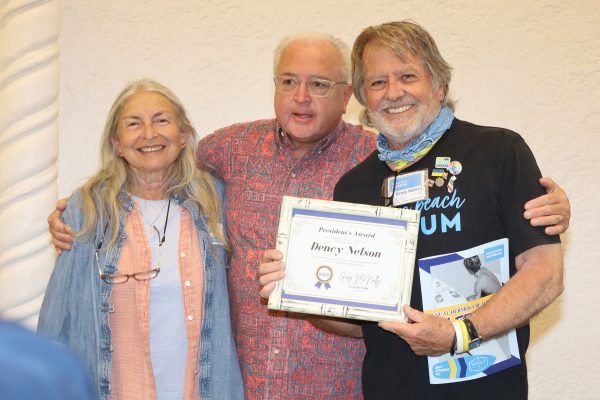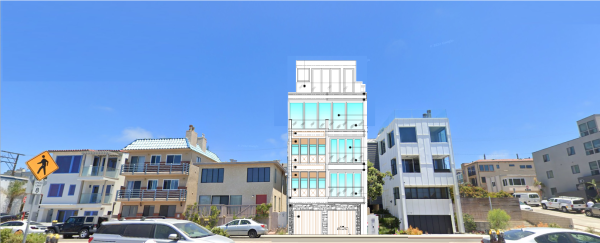by Mark McDermott
If this was their last rodeo, Councilmembers Richard Montgomery and Steve Napolitano left the Manhattan Beach City Council much the way each had served over their collective nine terms, the last two serving together.
Montgomery is known for his elephantine memory of most municipal business across the last two decades, and for his effectiveness at relationship-building, particularly as the City’s mayor at the onset of the pandemic, when regional cooperation was particularly important. On Tuesday night, he successfully argued to grant the City’s largest contractor, Waste Management, a fee increase that went beyond its existing contract. He recalled that early in the pandemic the trash hauler came to the City’s aid in a time of duress, agreeing to pick up trash three times daily — rather than three times a week, as it had previously — to help accommodate the emergency outdoor dining program the Council had devised to aid struggling restaurants.
Montgomery made the motion to approve the unusual fee increase. He noted that Waste Management incurred $150,000 in added costs by helping the City, costs that have been ongoing now for four years.
He cited it as evidence that Waste Management, which has been the City’s waste hauler for 30 years, has been a trusted partner.
“At the worst possible time in the world, they stuck up for us,” he said. “I don’t forget that — at their own cost.”
Waste Management in July asked for a rate increase outside what is allowed in its contract due to a spike in its labor costs that are a lingering result of the pandemic. Bruce Moe, who was city manager at the time, originally denied the request, but the Council heard the matter, and largely due to Montgomery and Napolitano’s arguments, revisited the proposed rate increase Tuesday night.
Napolitano has unparalleled institutional memory. He first served on the council, as its youngest member ever, at 26, and recalled how his council colleague at the time, Don Stern, argued to go out to bid for a new trash contract, saving millions when they first brought in Waste Management. Napolitano also served as a deputy for LA County Supervisor Don Knable for over a dozen years, and so likewise knew the trash hauling business from a regional perspective.
“They all make promises. They don’t all deliver on them,” he said. “…We’ve had folks who have made promises, and they work a little bit and then they take off. That was our experience with street sweeping, and that’s what really concerned me when Waste Management came to us. Because they’re a million dollars in a hole in their service to Manhattan Beach. We have a solid contract, and we paid good money to negotiate that contract. But I’m going to say now what I said a few months ago, and that is we want to be good partners. We can’t sit there and expect a contractor to go a million dollars in a hole per year and expect that quality service to continue, or to expect the care and the extra mile that they have gone in different situations.”
Mayor Amy Howorth praised her outgoing colleagues for their approach to the issue. Both are termed out, and will officially leave the dais December 17.
“I really appreciate the comments about being a good partner,” she said to Montgomery. “I also want to say tonight that Councilman Napolitano, your experience going back to the days with Dan Stern, or when you were with the County, has been so invaluable to this community. It just really helps.”
Napolitano began to protest.
“I know,” Howorth said, cutting him off. “I am doing it because I know you hate it.”
The proposed one-time flat increase was 2.51 percent for residential and 5.4 percent for commercial customers. City staff surveyed seven surrounding cities and found that Manhattan Beach’s current trash fee for residents, $23.06, was the second lowest behind Hermosa (at $22.70) while Lomita residents pay $33.69, or 46 percent more. “Sorry, Lomita,” Napolitano said. “[Mayor] Mark Woronek, get to work on that.” The fee increase would still leave Manhattan Beach tied for second lowest with Inglewood. The City likewise has the second lowest commercial rate, at $231.04, with only Redondo at $223.49 lower, and Lomita again leading the pack at $388.43. The average residential fee is $27.10, representing 17.5 percent higher than Manhattan Beach’s, while the average commercial fee is $270.43, 17 percent higher than Manhattan Beach.
The Waste Management contract specifically stated that labor costs are not a valid reason for a fee increase. Councilmember David Lesser argued this specificity was why the City needed to keep the current contract intact. He said the City could go out to bid for a new contractor if need be.
“I cannot support the motion because this was the bargain we struck,” Lesser said. “I’m also a believer in competitive bidding.”
Waste Management’s contract runs through 2027, with a three-year option to extend to 2030. Napolitano said that seeking a new hauler would almost certainly end up costing the City more money.
“What we don’t want to do is begin to pull out of a contract,” he said. “Sure, we can assess penalties, but then we need to find someone else to pick up the trash for us, find another hauler, go out to bid. All that takes time and then paying a whole lot more than what we would be paying now. And so we want to avoid that kind of fail situation, and to do that, this seems to be the best way out.”
The motion passed 4-1 with Lesser in dissent.
Public art protection
In another matter, Napolitano was able to bring to bear perhaps his own most treasured role as a councilperson, that of aesthetic critic.
Early in the evening, the Council sent staff back to the drawing board — for the second time — regarding a proposed new citywide wayfinding and signage program.
Napolitano didn’t like anything about the new signs, or, in one case, large rocks that serve as welcomes at the City borders.
“Who can I fire over this?” he asked.
“No one,” Howorth quickly interjected.
The new program would have doubled down on the use of rocks as signs. Napolitano likened them to the Stone Age television show, the Flinstones, and their hometown.
“Nobody asked for a rock,” Napolitano said. “I hate the boulders that are out there now. Wish we destroyed them yesterday. They’re ugly. They’re from Bedrock.”
Later in the night, the Council considered and later approved a $770,000 outlay from its Public Art Fund to repair and better protect several prioritized public art pieces. Napolitano, an art student in his college days who has been the key force behind the City’s burgeoning public art program, took the opportunity to atone for what he called his worst decision in five terms as a councilmember. He moved to decommission a large mural on the pier’s retaining wall.
“This is the one decision that has bothered me in all my years,” he said, noting that the mural’s commissioning was a compromise choice late into a long ago public art deliberation at a council meeting. “That tile mural was a runnerup and a second choice, and everyone finally just said, okay ….That is the greatest canvas that we have in the city to do something with, but what’s out there now is ugly. It’s falling apart.”
After some consultation with City Attorney Quinn Barrow, the Council determined that decommissioning that art piece was within the scope of the current agenda item. Napolitano pumped his fist. The motion then passed 5-0.
“Now,” he said, “I feel complete.” ER









